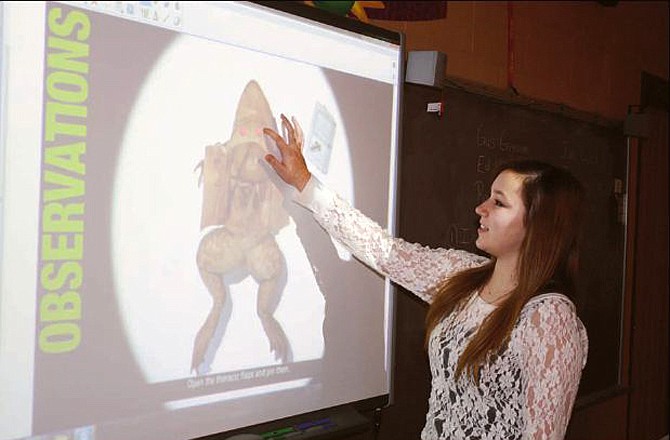EUGENE, Mo. - By the time Patty Smith's middle school science class sits down at the lab table to stare down at a real frog prepared for dissection, they should be at ease.
With the help of technology, Smith is able to demonstrate the dissection process several times and in different ways, so the students are not worried or afraid.
First students watch a video of the lab procedure. Then, they use one of Cole County R-5 School's multiple computer labs so students can conduct a virtual dissection.
Next, Smith used the latest technology acquisition, a document camera, which projects the image it sees on to the classroom screen, to demonstrate the dissection. In the past, she attempted the same idea to a smaller scale with a microscope camera.
And finally, the day comes when the eighth-graders must apply what they've learned.
"It makes them more comfortable when the frog is in front of them; it removes the guess work," Smith said.
Technology has become as much a necessity in a classroom as a stapler.
At Cole County R-5 schools, "we're beginning the process to go beyond the norm," Smith said.
Dayna Limbach's fourth-grade classroom was one of the first in the building to receive a Smartboard, when that technology was new more than seven years ago. Today, every elementary classroom is equipped with the device, which allows students to touch the screen directly and manipulate the images.
"The elementary kids like to touch," Limbach said.
In the middle school, math classes use a notebook projector, controlled by a hand-held tablet for the teacher. But many seventh- through ninth-grade classes also have Smartboards.
"It's hard to get 32 kids at the board at one time," Smith noted.
Many classrooms also have Clicker technology, which provides hand-held responders for each student. They can do flash card-like games or respond to multiple choice questions from the teacher's whiteboard.
The Clickers help teachers judge students at an individual level for understanding. They enable a more swift and efficient instructional process, Smith said.
In her science classes, she can give a quiz at the beginning of class to see how much students remembered from yesterday or preview the upcoming lesson content to see if they already know the material.
"It makes the ability of only one computer in a classroom available to everyone," Limbach said.
On the horizon, the teachers intend to apply for grants to put tablet technology in the hands of each student in a classroom.
"It takes us out of the paper world," Smith said. "They'll be able to do things on their own faster than we can understand."
Although Smith, Limbach and their professional peers recognize the educational benefits of incorporating technology into their everyday lessons, it has been more of a learning curve for them than the students.
The high school Smith attended didn't even have computers yet, when she graduated.
Yet, today's preschoolers often know how to operate iPhones and other aspects of the digital world.
"We have to adjust to them," Smith said.
The result is a more individualized instruction. Students who grasp the lesson's concept can go on to enrichment activities while students who need help can get it.
"It expands everybody's learning," Smith said.

